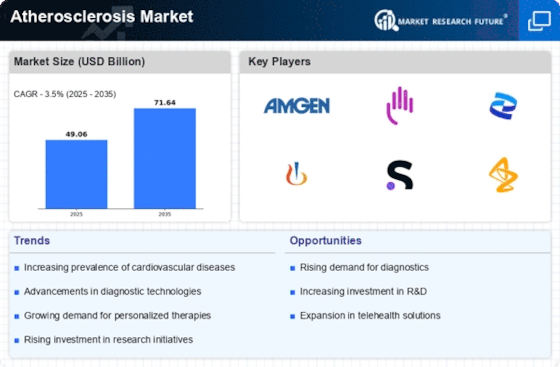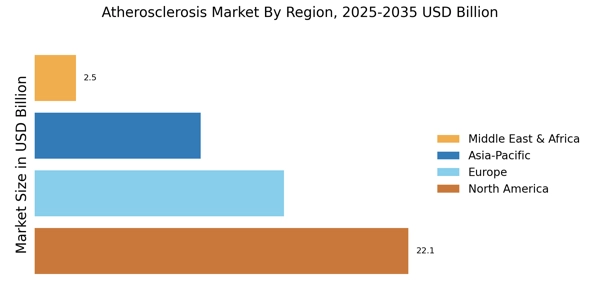Expansion of Treatment Options
The Atherosclerosis Market is witnessing a significant expansion in treatment options, driven by ongoing research and development efforts. Novel pharmacological therapies, including PCSK9 inhibitors and novel antiplatelet agents, are emerging as effective alternatives to traditional treatments. These advancements provide healthcare professionals with a broader array of tools to manage atherosclerosis effectively. Additionally, the development of personalized medicine approaches allows for tailored treatment plans based on individual patient profiles, potentially improving therapeutic outcomes. As the market diversifies with new treatment modalities, healthcare providers are better equipped to address the complexities of atherosclerosis management. This expansion is likely to attract investment and foster competition within the Atherosclerosis Market, ultimately benefiting patients.
Rising Awareness and Education
There is a notable increase in awareness regarding cardiovascular health, which significantly impacts the Atherosclerosis Market. Public health campaigns and educational initiatives have been instrumental in informing individuals about the risks associated with atherosclerosis and the importance of early detection. This heightened awareness encourages individuals to seek medical advice and undergo regular screenings, leading to earlier diagnosis and treatment. Consequently, healthcare providers are witnessing an uptick in patient consultations related to cardiovascular health. The emphasis on preventive care and lifestyle modifications is likely to drive demand for atherosclerosis-related products and services. As awareness continues to grow, the Atherosclerosis Market may experience a shift towards more comprehensive care models that prioritize prevention and management.
Government Initiatives and Funding
Government initiatives aimed at combating cardiovascular diseases are playing a crucial role in shaping the Atherosclerosis Market. Increased funding for research, public health campaigns, and healthcare infrastructure development is evident in various regions. These initiatives often focus on promoting awareness, improving access to care, and supporting innovative research projects. For instance, government-sponsored programs may provide grants for studies exploring new treatment modalities or preventive strategies for atherosclerosis. Such funding not only enhances the overall understanding of the disease but also encourages collaboration between public and private sectors. As governments prioritize cardiovascular health, the Atherosclerosis Market is likely to benefit from enhanced resources and support, fostering growth and innovation.
Increasing Prevalence of Atherosclerosis
The rising incidence of atherosclerosis is a primary driver in the Atherosclerosis Market. Factors such as sedentary lifestyles, unhealthy dietary habits, and increasing obesity rates contribute to this trend. According to recent health statistics, atherosclerosis affects millions worldwide, with projections indicating that the number of affected individuals may continue to rise. This growing patient population necessitates enhanced treatment options and preventive measures, thereby stimulating market growth. Furthermore, the aging population is particularly susceptible to cardiovascular diseases, including atherosclerosis, which further amplifies the demand for effective therapies and interventions. As healthcare systems adapt to these challenges, investments in research and development are likely to increase, fostering innovation within the Atherosclerosis Market.
Technological Innovations in Diagnostics
Technological advancements in diagnostic tools are transforming the Atherosclerosis Market. Innovations such as advanced imaging techniques, including high-resolution ultrasound and magnetic resonance imaging, enable healthcare professionals to detect atherosclerosis at earlier stages. These technologies facilitate more accurate assessments of arterial health, allowing for timely interventions. The integration of artificial intelligence and machine learning in diagnostic processes further enhances the precision of identifying risk factors associated with atherosclerosis. As these technologies become more accessible, healthcare providers are likely to adopt them, leading to improved patient outcomes. The demand for cutting-edge diagnostic solutions is expected to drive growth within the Atherosclerosis Market, as stakeholders seek to enhance the quality of care provided to patients.


















Leave a Comment